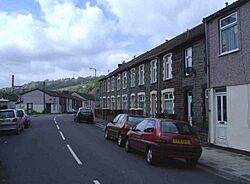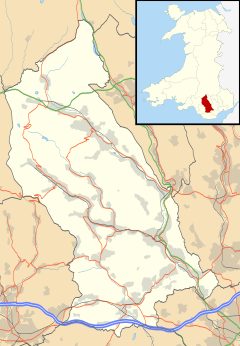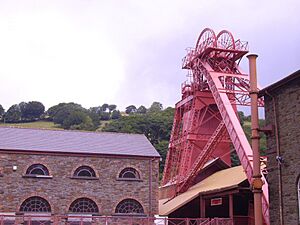Trehafod facts for kids
Quick facts for kids Trehafod |
|
|---|---|
 |
|
| Population | 698 (2011) |
| OS grid reference | ST044909 |
| Principal area |
|
| Ceremonial county | |
| Country | Wales |
| Sovereign state | United Kingdom |
| Post town | PONTYPRIDD |
| Postcode district | CF37 |
| Dialling code | 01443 |
| Police | South Wales |
| Fire | South Wales |
| Ambulance | Welsh |
| EU Parliament | Wales |
| UK Parliament |
|
| Welsh Assembly |
|
Trehafod is a small village in the Rhondda Valley, located in Wales. It sits between the towns of Porth and Pontypridd. In 2011, about 698 people lived here. Trehafod is part of the county borough of Rhondda Cynon Taf. The name "Trehafod" was chosen in 1905 to avoid confusion with another place called Hafod near Swansea.
This village used to be a busy coal mining area. Today, it's home to the Rhondda Heritage Park. This park is a popular place for visitors. It helps everyone remember the important history of coal mining in the Rhondda Valley.
Contents
A Look Back in Time: Trehafod's History
Long ago, in 1847, maps of this area showed several farms. These farms were called Hafod Uchaf, Hafod Ganol, and Hafod Fawr. The village of Trehafod got its name from these old farms.
The word "Hafod" comes from the Welsh language. It means "summer dwelling." This name refers to farms high up on a hillside. Farmers would take their cattle there to graze during the summer months. The word "Tre" means "town" or "settlement." In the 1800s, it was used for streets where workers lived.
Trehafod's Railway Connection
The Trehafod railway station is on the Rhondda Line. This railway line follows the River Rhondda. The river and the railway line run along both sides of the village. This shows how important the river and trains were to the village's growth.
The Rhondda Heritage Park
Trehafod is now best known for the Rhondda Heritage Park. This park used to be the Lewis Merthyr Colliery. At its busiest, this coal mine was one of the most productive in the South Wales Coalfield. Today, it's a fun and educational place to visit. You can learn all about the history of coal mining.
Barry Sidings Countryside Park
Trehafod also has a lovely place called Barry Sidings Countryside Park. Many local people call it "the lakes" because it has two ponds. This park is a favorite spot for families and people walking their dogs.
- It has nice nature paths to explore.
- You can see a small waterfall.
- There are ducks, carp fish, and frogs in the ponds.
- There's even a café where you can get a snack.
The park is mostly in Trehafod. It also connects to Pontypridd, so many walkers use it to get there.
Dealing with Flooding
The village of Trehafod has sometimes had problems with flooding from the river. The most serious flood happened in 1960. Sadly, one person living on Afon Street lost their life during that flood. "Afon" is the Welsh word for 'river'.
Other floods happened in 1921, 1929, and 1979. After the 1979 flood, the banks of the Rhondda River were made stronger. A big project to improve the river was finished in 1985. However, the village has still experienced significant flooding since then, including in February 2020.



